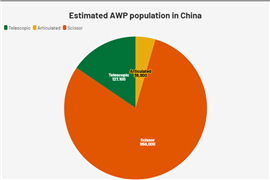GB construction fall
15 March 2017
Construction output in Great Britain fell by 0.4% in January 2017 compared with December 2016, although output grew on a quarter-on-quarter basis by 1.8%.
The latest figures from the Office for National Statistics (ONS) showed that within the various sectors, repair and maintenance fell 1.3% month-on-month in January, with decreases recorded in public housing and non-housing repair and maintenance.
All new work showed signs of flattening out with growth of just 0.1% in January 2017, but this sector continued to grow in the latest three-month period compared with the previous three months, at a rate of 2.1%.
It said that infrastructure grew month-on-month for the third time in a row, increasing 3.5% in January 2017, despite showing a decrease over the same month a year earlier for the 13th consecutive month.
Overall annual construction output growth has increased for 2016, to 2.4% from 1.5%, as a result of upward revisions for all four quarters, including a revision of 0.8% in the fourth quarter (Oct to Dec) 2016, from 0.2% to 1%.
New orders fell by 2.8% in the fourth quarter of 2016, driven mainly by falls in private industrial and private commercial work, the ONS figures showed.
Despite new orders falling in the final quarter of 2016, the annual volume of new orders was said now to be at its highest level since 2008.
‘Disappointing’
Rebecca Larkin, senior economist at the UK’s Construction Products Association, said, “Following an increase in output in the fourth quarter of last year, the overall fall in construction output in the opening month of 2017 was disappointing, with a decrease in housing, industrial, commercial and RM&I (repair, maintenance and improvement) activity over the month.
“Furthermore, the construction new orders data from the ONS suggests that there may be continued weakness in activity in some sectors during 2017. Commercial new orders tailed off in the second half of 2016, and in the fourth quarter were 10.6% lower than in the third quarter, and fell 24.1% from a year ago, and new orders in the industrial sector were the lowest in two years.”
She added, “Building work in both sectors requires a large up-front investment for a long-term rate of return, and it appears decision-making has been clouded by a rise in economic uncertainty.”
Larkin said that taking total new orders growth of 2.9% in 2016 as a whole, however, showed that there remained an impetus for construction activity over the next 12 months.
“As echoed in our forecasts, output during 2017 will be driven by higher orders for housing – both private and public – as well as infrastructure and new public sector buildings such as schools and hospitals,” she said.
‘Fragile recovery’
Michael Thirkettle, chief executive of interdisciplinary international construction and property consultancy McBains Cooper, said the figures showed that a real recovery for construction was fragile at best.
“In the short to medium term, worries over Brexit (the UK’s decision to leave the European Union) remain a constant,” he said. “We stand to lose a significant number of the 12% of UK construction workers who come from EU countries, as a result of Brexit – which means we will be in a parlous situation.”
Figures this week from RICS (the Royal Institution of Chartered Surveyors) suggested that the UK construction industry could lose almost 200,000 EU workers post-Brexit should Britain lose access to the single market, putting some of the country’s biggest infrastructure and construction projects under threat.
It said the UK was already in the grip of a construction skills crisis, and added that while some overseas professionals, such as ballet dancers, were regarded as critical by the UK government, and therefore prioritised during the visa application process, construction professions have not yet been added to the UK Shortage Occupations List.
RICS said it was warning that this could already be placing the UK’s predicted £500 billion (€574 billion) infrastructure pipeline under threat and had to be addressed as a priority.
STAY CONNECTED



Receive the information you need when you need it through our world-leading magazines, newsletters and daily briefings.
CONNECT WITH THE TEAM











